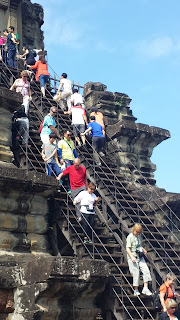We visited 3 ancient Buddhist temples in Angkor, a holy city that took centuries to build. The Khmer aristocrats who built the temples and monuments between AD 800-1200 were motivated by their Hindu and Buddhist beliefs.
Our first stop was Angkor Thom (the big holy place).
 |
| Statue of the Hindu god Vishnu at an entrance |
 |
| The longest continuous bas relief in the world--nearly one-half mile!!! |
We all climbed to the second level, but only Britt, Thu, and Roger climbed all the way up to the third level.
 |
| Our yummy sticky rice ball with freshly grated coconut |
 |
| Hope's kitchen |
 |
| Hope |
 |
| Enjoying our lunch |
After lunch Mel was accosted by the local children offering items for sale "You buy one dolla? One dolla? Two for one dolla?" Mel succumbed, of course.
After lunch was our visit to famous Angkor Wat (city temple). It is a masterpiece of Khmer architecture built between 1113-1150 AD surrounded by a moat of 570 feet.
After a delicious farewell dinner at our hotel last night, we're about to board a plane to Bangkok where we'll spend the night before starting our long, long trek home tomorrow. I'm sure we'd all agree this has been an incredible journey.

















































